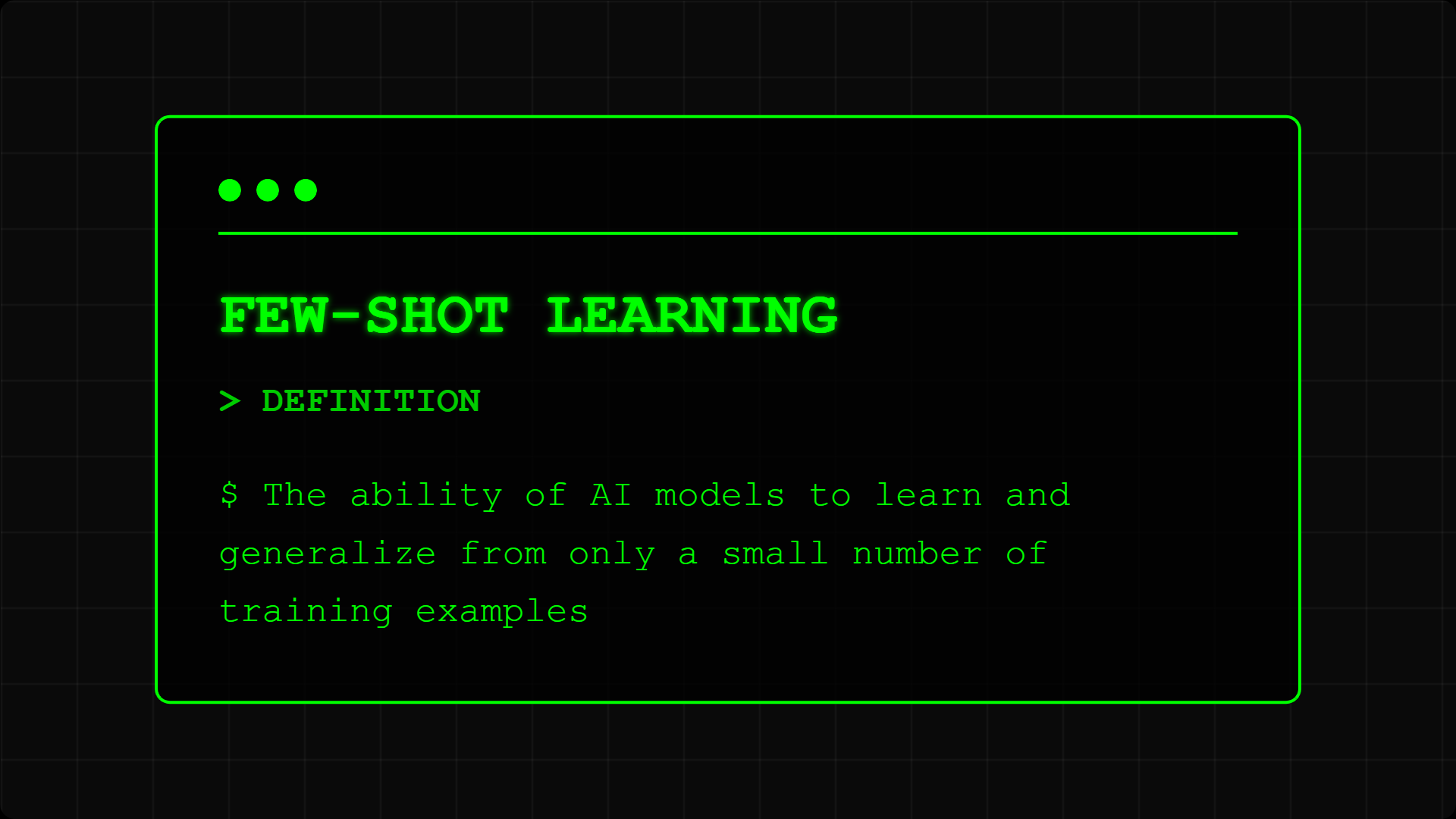AI Terms
What is Few-shot Learning? When AI Learns Like Humans Do

Show a child three pictures of zebras, and they'll recognize zebras everywhere. Traditional AI needed thousands of examples. Few-shot learning brings human-like learning efficiency to machines, enabling AI to understand new concepts from just a handful of examples.
Technical Foundation
Few-shot learning is a machine learning paradigm where models learn to perform new tasks with only a few training examples – typically 2-10 per class. This contrasts sharply with traditional deep learning that requires thousands or millions of labeled examples.
The concept emerged from cognitive science observations that humans can generalize from limited examples. According to MIT's research, few-shot learning "mimics human cognitive abilities by leveraging prior knowledge to rapidly adapt to new tasks with minimal data."
Technically, few-shot learning works through meta-learning (learning to learn), metric learning (learning similarity functions), or prompt-based methods that leverage large pre-trained models' existing knowledge.
Business Value Proposition
For business leaders, few-shot learning means AI that can adapt to new products, customers, or scenarios in hours instead of months – using just a few examples rather than massive datasets.
Imagine onboarding a new team member who becomes productive after seeing just three examples of how you want things done. That's few-shot learning – AI that grasps your specific needs quickly without extensive training.
In practical terms, this enables rapid prototyping, quick adaptation to new markets, and AI deployment in scenarios where collecting large datasets is impossible or impractical.
Core Mechanisms
Few-shot learning operates through:
• Prior Knowledge Base: Models pre-trained on diverse data that understand general concepts and relationships
• Similarity Learning: Ability to recognize what makes examples similar or different, generalizing from few instances
• Meta-Learning Framework: Learning algorithms that optimize for quick adaptation rather than task-specific performance
• Prompt Engineering: Techniques to activate relevant knowledge in pre-trained models using natural language instructions
• Support Sets: Small collections of examples that define the new task or category
How Few-shot Learning Functions
The process typically follows:
Foundation Training: Model learns general knowledge from large, diverse datasets, building understanding of concepts and relationships
Task Presentation: New task defined by showing 2-10 examples (support set) of what you want the model to learn
Rapid Adaptation: Model applies its general knowledge to understand the pattern in your few examples and generalize to new instances
Unlike traditional training that modifies the entire model, few-shot learning often just adjusts how existing knowledge is applied.
Few-shot Learning Approaches
Different techniques for different scenarios:
Approach 1: Prototype Networks Best for: Classification tasks Method: Learn representative prototypes for each class Example: Identifying new product defects from 5 examples
Approach 2: Prompt-based Learning Best for: Language tasks Method: Craft instructions that activate model knowledge Example: Customer service responses for new products
Approach 3: Model-Agnostic Meta-Learning (MAML) Best for: Diverse task types Method: Optimize for quick adaptation Example: Personalized recommendations for new users
Approach 4: Siamese Networks Best for: Similarity matching Method: Learn to compare examples Example: Facial recognition for building access
Real-World Applications
Companies leveraging few-shot learning:
E-commerce Example: Amazon's product categorization system uses few-shot learning to classify new products into thousands of categories using just 3-5 example products, enabling rapid marketplace expansion.
Healthcare Example: Google Health developed a few-shot learning system that adapts to rare diseases using fewer than 10 patient examples, democratizing AI diagnosis for conditions affecting small populations.
Customer Service Example: Anthropic's Claude can learn company-specific terminology and response styles from just a few examples in prompts, eliminating months of custom training.
When Few-shot Learning Excels
Ideal scenarios include:
• Rare Events: Fraud patterns, equipment failures, or unusual customer behaviors with few historical examples • Rapid Deployment: New product launches, market entry, or seasonal campaigns needing immediate AI support • Personalization: Adapting to individual customer preferences with minimal interaction history • Long-tail Problems: Thousands of categories each with few examples • Privacy Constraints: When collecting large datasets is impossible due to regulations
Limitations to Consider
Few-shot learning has boundaries:
• Complex Tasks: Some problems genuinely need extensive examples • High Precision Requirements: Few-shot may sacrifice some accuracy • Novel Domains: Works best when related to pre-training data • Consistency: Performance can vary with example selection
Implementation Strategy
Ready to deploy AI with minimal data?
- Understand foundations with Transfer Learning
- Master Prompt Engineering for language models
- Explore Meta-Learning concepts
- Read our Few-shot Learning Guide
Part of the [AI Terms Collection]. Last updated: 2025-01-11